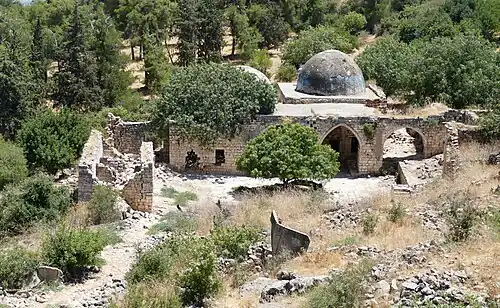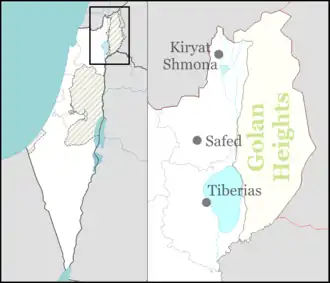Maqam an-Nabi Yusha'
| Maqam an-Nabi Yusha' | |
|---|---|
مقام النبي يوشع | |
 Maqam an-Nabi Yusha' in 2022 | |
| Religion | |
| Affiliation | Shia Islam (former) |
| Ecclesiastical or organizational status | |
| Status | Inactive (partial ruins) |
| Location | |
| Location | Safad, Northern District |
| Country | Israel |
| Geographic coordinates | 33°06′46″N 35°33′24″E / 33.1127403°N 35.5565771°E |
| Architecture | |
| Type | Islamic architecture |
| Completed | 18th century |
| Specifications | |
| Dome(s) | Two |
| Shrine(s) | One: Joshua (desecrated) |
The Maqam an-Nabi Yusha' (Arabic: مقام النبي يوشع) is a former Shi'ite mosque and the shrine, now in a partial ruinous state, located in the abandoned village of Al-Nabi Yusha' in Safed, in the Northern District of Israel. A mausoleum in the structure, one of the historic maqams in the Middle East, is believed to entomb the remains of the biblical Joshua.[1][2][3][4][5]
History
The religious complex was founded in the 18th century by the aristocratic Alghul family.[5][3][6] During the Mandate period, the residents of Al-Nabi Yusha' (who were mostly Shi'ites) celebrated an annual mawsim festival at the site dedicated to the entombed prophet.[5][3] In 2018, the site was vandalized by unknown perpetrators, who sprayed Talmudic graffiti on its walls.[7]
Architecture
The Maqam an-Nabi Yusha' is a rectangular structure formed around a courtyard aligned north–south with an arched entrance on the north end while the two domed chambers, including the shrine-mausoleum, were located on the south end of the complex.[1][2][6] The shrine is surrounded by fig trees and species of cactus growing around it.[5]
Gallery
-
 The Maqam an-Nabi Yusha', c. 1930s, before it was ruined
The Maqam an-Nabi Yusha', c. 1930s, before it was ruined -
 The interior of the shrine-mausoleum, the simple grave dedicated to Joshua is visible in front of the mihrab, painted in white
The interior of the shrine-mausoleum, the simple grave dedicated to Joshua is visible in front of the mihrab, painted in white -
 Courtyard of the Maqam an-Nabi Yusha'
Courtyard of the Maqam an-Nabi Yusha' -
 Ruins of the hallways of the mosque
Ruins of the hallways of the mosque -
 Inside the mosque part's main chamber
Inside the mosque part's main chamber
See also
References
- ^ a b Petersen, Andrew (2001). A gazetteer of buildings in Muslim Palestine. 1. British Academy monographs in archaeology. Oxford: Oxford University Press. ISBN 978-0-19-727011-0.
- ^ a b Guérin, V. (1880). Description Géographique Historique et Archéologique de la Palestine (in French). Vol. 3: Galilee, pt. 2. Paris: L'Imprimerie Nationale.
- ^ a b c Zochrot. "Zochrot - al-Nabi Yusha". Zochrot - al-Nabi Yusha'. Retrieved April 22, 2024.
- ^ "Palestine Remembered: Al-Nabi Yusha' village in Safad".
- ^ a b c d Khalidi, Walid (1992). All that remains: the Palestinian villages occupied and depopulated by Israel in 1948. Washington (D.C.): Institute for Palestine studies. ISBN 978-0-88728-224-9.
- ^ a b backpackisrael (November 18, 2020). "Hiking the Israel National Trail: From Nabi Yusha to Gesher Alma". Backpack Israel. Retrieved April 22, 2024.
- ^ تدنيس مقام النبي يوشع بصفد بعبارات تلمودية. فلسطين أون لاين [felesteen.news] (in Arabic). February 9, 2018. Retrieved April 22, 2024.
